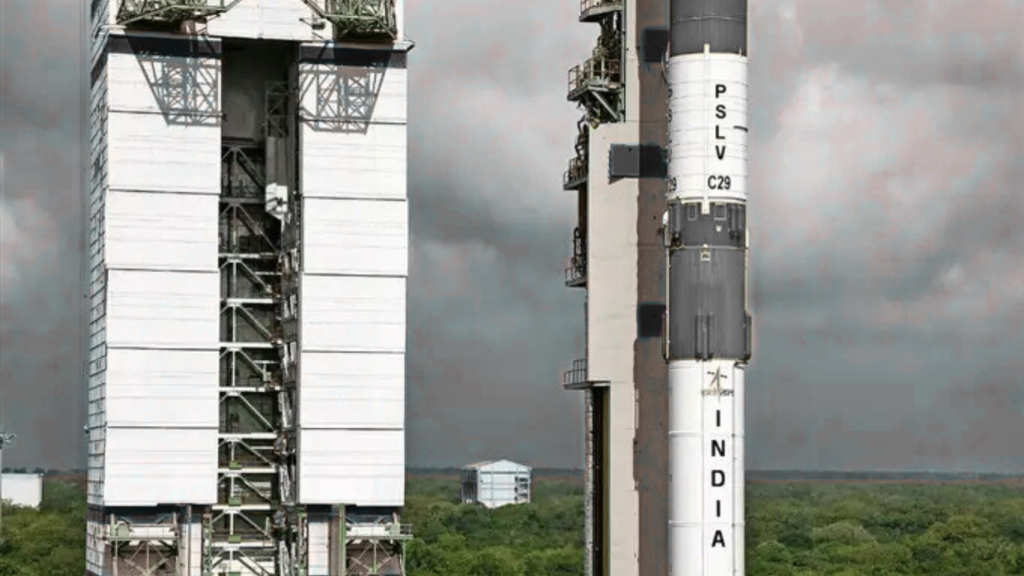The PSLV, or Polar Satellite Launch Vehicle, is India’s trusted rocket for launching satellites into orbit. Built by the Indian Space Research Organisation (ISRO), it’s been a game-changer since its first flight in 1993. Known as ISRO’s “workhorse,” the PSLV has launched over 60 missions, carrying satellites for India and other countries. Its ability to place satellites in precise orbits, especially polar ones, makes it special. From weather monitoring to lunar missions, the PSLV has helped India shine in the global space race. This article explains what the PSLV is, its full form, how it works, and why it matters. Whether you’re new to space stuff or just curious, read the story of this amazing rocket and its role in India’s space dreams.
What Does PSLV Stand For?
The full form of PSLV is Polar Satellite Launch Vehicle. It’s a rocket designed to carry satellites into specific orbits, especially polar orbits, where satellites pass over Earth’s poles. These orbits are great for satellites that need to scan the entire planet, like those for weather, mapping, or spying. ISRO developed the PSLV to make India self-reliant in launching satellites, reducing dependence on other countries. First flown in 1993, the PSLV has become a reliable choice, with only three failures in 63 missions by May 2025. Its name reflects its purpose: “Polar” for the orbit type, “Satellite” for what it carries, and “Launch Vehicle” for its role as a rocket. The PSLV’s success has put India on the global space map, launching everything from small cubesats to lunar probes.
Why the Name Matters
The name “Polar Satellite Launch Vehicle” isn’t just a fancy title. It tells us what the rocket does. Polar orbits let satellites cover Earth’s surface systematically, ideal for tasks like monitoring crops or tracking storms. The “Launch Vehicle” part means it’s built to carry payloads into space reliably. ISRO chose this name to highlight the PSLV’s focus on precision and versatility. Understanding the name helps us appreciate how this rocket supports India’s goals, from scientific research to national security.
Evolution of the PSLV
The PSLV has grown since its debut. Early versions carried lighter payloads, but ISRO developed variants like the PSLV-XL, which can handle heavier satellites, up to 1,750 kg to polar orbits. The rocket’s design has been tweaked over 30 years, improving reliability and capacity. By 2025, it’s flown 63 missions, including high-profile ones like Chandrayaan-1. Each upgrade, from better strap-on boosters to advanced navigation, has made the PSLV a global favorite for affordable launches.
How Does the PSLV Work?
The PSLV is a four-stage rocket, meaning it has four sections that fire one after another to reach space. The first and third stages use solid fuel, like a giant firecracker that burns steadily. The second and fourth stages use liquid fuel, which can be controlled for precision. This mix allows the PSLV to climb through Earth’s atmosphere and place satellites exactly where they need to be. Strap-on boosters, small rockets attached to the first stage, give extra power for heavier loads. The PSLV’s navigation system ensures satellites reach orbits like sun-synchronous or geostationary ones. Its ability to handle different missions, from launching one satellite to 104 in a single go, shows its flexibility. The PSLV’s design is a balance of power, accuracy, and cost, making it a star in ISRO’s lineup.
The Four-Stage Design
The PSLV’s four stages work like a relay team. The first stage, with solid fuel, provides the initial thrust to lift off. The second stage, using liquid fuel, takes over to push through the atmosphere. The third stage, solid again, gives a big boost in space. The fourth stage, liquid-fueled, fine-tunes the satellite’s orbit. Strap-on boosters can be added for extra power. This design lets the PSLV carry up to 3,250 kg to low Earth orbits or 1,750 kg to polar orbits, making it versatile for various missions.
Variants of the PSLV
The PSLV comes in different flavors to suit different needs. The standard PSLV-G has six strap-on boosters, while the PSLV-XL has larger boosters for heavier payloads, like the EOS-09 satellite. The PSLV-CA (Core Alone) skips boosters for lighter missions. These variants let ISRO handle everything from small cubesats to lunar probes. By 2025, the XL variant has flown 27 times, proving its reliability for big missions like Chandrayaan-1 and Mars Orbiter.
The PSLV’s Role in India’s Space Program
The PSLV has been the backbone of ISRO’s success. It’s launched over 300 satellites, including India’s weather, navigation, and spy satellites, plus payloads for countries like the US, UK, and Israel. Its low cost—around $15-20 million per launch—makes it a global favorite. The PSLV made history with missions like Chandrayaan-1, India’s first lunar probe, and the Mars Orbiter, which reached Mars on a budget. In 2017, it set a record by launching 104 satellites in one mission. Despite a recent failure in May 2025 with PSLV-C61, its 60 successful missions since 2017 show its strength. The PSLV’s ability to deliver satellites precisely has boosted India’s reputation as a space power, supporting both scientific and practical needs.
Key Missions Powered by PSLV
The PSLV has starred in some of India’s biggest space moments. In 2008, it launched Chandrayaan-1, India’s first moon mission, which found water molecules on the lunar surface. In 2013, it sent the Mars Orbiter, making India the first Asian nation to reach Mars. The 2017 mission, launching 104 satellites, showed the PSLV’s ability to handle complex tasks. These missions put India on the global stage, proving it could achieve big results with small budgets.
Supporting Global Clients
The PSLV isn’t just for India—it’s a global player. ISRO has used it to launch satellites for over 20 countries, including nanosatellites for universities and companies. In 2019, it launched EMISAT, a spy satellite, alongside 28 foreign satellites. These commercial launches earn money for ISRO while showcasing the PSLV’s reliability. Its low cost and precision make it attractive for clients who want affordable access to space, strengthening India’s role in the global space market.
Why the PSLV Is Special
The PSLV stands out for its reliability, affordability, and versatility. With a success rate of over 95%, it’s one of the world’s most dependable rockets. Its ability to launch satellites into polar, sun-synchronous, or geostationary orbits makes it a Swiss Army knife for space missions. Unlike bigger rockets like NASA’s SLS, the PSLV is cost-effective, letting ISRO do more with less. It’s also eco-conscious, with features like deorbiting systems to reduce space junk. The PSLV’s success has inspired India’s youth, sparking interest in science and engineering. Even after setbacks, like the PSLV-C61 failure in 2025, ISRO’s quick response shows why the PSLV remains a trusted tool for India’s space ambitions and a symbol of national pride.
Affordability and Efficiency
The PSLV’s low cost—about $15-20 million per launch—is a big deal. Compared to rockets like SpaceX’s Falcon 9, which can cost $60 million, the PSLV offers a budget-friendly option without sacrificing reliability. This efficiency comes from ISRO’s smart engineering, using simple materials and in-house technology. The PSLV’s ability to launch multiple satellites at once, like the 104-satellite mission, maximizes value. This affordability lets ISRO fund more missions and offer cheap launches to global clients.
Inspiring a Nation
The PSLV’s success has fired up India’s imagination. From schoolkids to scientists, it’s a symbol of what India can achieve. Missions like Chandrayaan-1 and the Mars Orbiter, launched by PSLV, have inspired students to pursue STEM careers. The rocket’s reliability has built national pride, showing India can compete with global powers despite a modest budget. Even setbacks like PSLV-C61 remind people that challenges are part of progress, encouraging resilience and innovation in India’s youth.
Challenges and the Road Ahead
The PSLV has had a stellar run, but it’s not perfect. The May 2025 PSLV-C61 failure, due to a third-stage issue, was a rare setback, only the third in 63 missions. ISRO is investigating to prevent future problems, showing its commitment to learning. As India’s space goals grow—think lunar bases and human spaceflight—the PSLV will need upgrades to handle heavier payloads and new orbits. ISRO is also working on reusable rockets to cut costs further. With four more PSLV launches planned for 2025, the rocket remains key to India’s plans. Its ability to adapt will ensure it keeps helping India reach for the stars, from new satellites to interplanetary missions.
Learning from Setbacks
The PSLV’s rare failures, like in 1993, 2017, and 2025, have taught ISRO valuable lessons. The 1993 software glitch led to better coding, while 2017’s heat shield issue improved stage separation. The 2025 failure, linked to a third-stage motor, will likely spark upgrades to propulsion systems. ISRO’s Failure Analysis Committees dive deep into data, ensuring fixes are thorough. This learning process keeps the PSLV reliable, with quick recoveries—often within months—showing ISRO’s strength in bouncing back.
Future Upgrades and Missions
ISRO isn’t resting on the PSLV’s success. Plans for 2025 include four PSLV launches, carrying satellites for navigation, weather, and more. The agency is exploring reusable versions of the PSLV to lower costs and compete with SpaceX. Upgrades to carry heavier payloads or reach higher orbits are also in the works. With missions like Gaganyaan, India’s human spaceflight program, on the horizon, the PSLV’s role as a reliable launcher will evolve, keeping India at the forefront of space exploration.
The PSLV’s Legacy and Impact
The PSLV, or Polar Satellite Launch Vehicle, is more than a rocket—it’s a symbol of India’s grit and ingenuity. Its full form reflects its purpose: launching satellites into polar orbits for science, security, and progress. From Chandrayaan-1 to global client launches, the PSLV has made India a space powerhouse. Its affordability, reliability, and versatility set it apart in a competitive field. Despite occasional hiccups, like the 2025 failure, the PSLV’s legacy is one of success and inspiration. As ISRO pushes for bigger goals, the PSLV will keep playing a starring role, carrying India’s dreams into space and showing the world what’s possible with hard work and smart ideas.
A Symbol of India’s Progress
The PSLV embodies India’s rise as a tech leader. Its success with missions like the Mars Orbiter, done on a $74 million budget, shows India’s knack for doing more with less. The rocket has launched satellites that help farmers, track storms, and secure borders, directly impacting lives. Its global launches have earned India respect and revenue. The PSLV’s story inspires a generation, proving that big dreams can come true, even with limited resources.
The PSLV in the Global Space Race
In a world where space is getting crowded, the PSLV gives India an edge. Its low cost and high success rate make it a go-to for countries and companies needing affordable launches. While SpaceX and China push reusable rockets, the PSLV’s reliability keeps it competitive. As ISRO plans lunar and human missions, the PSLV’s role in launching critical satellites ensures India stays a key player in the global space race, balancing cost and ambition.



